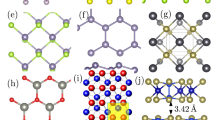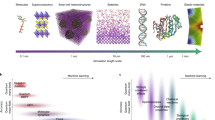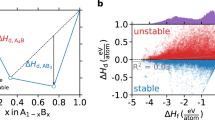Abstract
In multicomponent materials, short-range order (SRO) is the development of correlated arrangements of atoms at the nanometer scale. Its impact in compositionally complex materials has stimulated an intense debate within the materials science community. Understanding SRO is critical to control the properties of technologically relevant materials, from metallic alloys to functional ceramics. In contrast to long-range order, quantitative characterization of the nature and spatial extent of SRO evades most of the experimentally available techniques. Simulations at the atomistic scale have full access to SRO but face the challenge of accurately sampling high-dimensional configuration spaces to identify the thermodynamic and kinetic conditions at which SRO is formed and what impact it has on material properties. Here we highlight recent progress in computational approaches, such as machine learning-based interatomic potentials, for quantifying and understanding SRO in compositionally complex materials. We briefly recap the key theoretical concepts and methods.
This is a preview of subscription content, access via your institution
Access options
Access Nature and 54 other Nature Portfolio journals
Get Nature+, our best-value online-access subscription
$29.99 / 30 days
cancel any time
Subscribe to this journal
Receive 12 digital issues and online access to articles
$99.00 per year
only $8.25 per issue
Buy this article
- Purchase on Springer Link
- Instant access to full article PDF
Prices may be subject to local taxes which are calculated during checkout




Similar content being viewed by others
References
Yeh, J.-W. et al. Nanostructured high-entropy alloys with multiple principal elements: novel alloy design concepts and outcomes. Adv. Eng. Mater. 6, 299–303 (2004).
Cantor, B., Chang, I. T. H., Knight, P. & Vincent, A. J. B. Microstructural development in equiatomic multicomponent alloys. Mater. Sci. Eng. A 375–377, 213–218 (2004).
George, E. P., Raabe, D. & Ritchie, R. O. High-entropy alloys. Nat. Rev. Mater. 4, 515–534 (2019).
Oses, C., Toher, C. & Curtarolo, S. High-entropy ceramics. Nat. Rev. Mater. 5, 295–309 (2020).
Senkov, O. N., Wilks, G. B., Scott, J. M. & Miracle, D. B. Mechanical properties of Nb25Mo25Ta25W25 and V20Nb20Mo20Ta20W20 refractory high entropy alloys. Intermetallics 19, 698–706 (2011).
Gali, A. & George, E. P. Tensile properties of high- and medium-entropy alloys. Intermetallics 39, 74–78 (2013).
Otto, F. et al. The influences of temperature and microstructure on the tensile properties of a CoCrFeMnNi high-entropy alloy. Acta Mater. 61, 5743–5755 (2013).
Gludovatz, B. et al. A fracture-resistant high-entropy alloy for cryogenic applications. Science 345, 1153–1158 (2014).
Gludovatz, B., George, E. P. & Ritchie, R. O. Processing, microstructure and mechanical properties of the CrMnFeCoNi high-entropy alloy. JOM 67, 2262–2270 (2015).
Sarker, P. et al. High-entropy high-hardness metal carbides discovered by entropy descriptors. Nat. Commun. 9, 4980 (2018).
Ferrari, A., Lysogorskiy, Y. & Drautz, R. Design of refractory compositionally complex alloys with optimal mechanical properties. Phys. Rev. Mater. 5, 063606 (2021).
Bérardan, D., Franger, S., Dragoe, D., Meena, A. K. & Dragoe, N. Colossal dielectric constant in high entropy oxides. Phys. Status Solidi RRL 10, 328–333 (2016).
Bérardan, D., Franger, S., Meena, A. & Dragoe, N. Room temperature lithium superionic conductivity in high entropy oxides. J. Mater. Chem. A 4, 9536–9541 (2016).
Meisenheimer, P., Kratofil, T. & Heron, J. Giant enhancement of exchange coupling in entropy-stabilized oxide heterostructures. Sci. Rep. 7, 13344 (2017).
Braun, J. L. et al. Charge-induced disorder controls the thermal conductivity of entropy-stabilized oxides. Adv. Mater. 30, 1805004 (2018).
Ma, Y. et al. High-entropy metal-organic frameworks for highly reversible sodium storage. Adv. Mater. 33, 2101342 (2021).
Wagner, C. et al. Effects of Cr/Ni ratio on physical properties of Cr-Mn-Fe-Co-Ni high-entropy alloys. Acta Mater. 227, 117693 (2022).
Zhang, Y., Osetsky, Y. N. & Weber, W. J. Tunable chemical disorder in concentrated alloys: defect physics and radiation performance. Chem. Rev. 122, 789–829 (2021).
Li, Y. et al. Chemical ordering effect on the radiation resistance of a CoNiCrFeMn high-entropy alloy. Comput. Mater. Sci. 214, 111764 (2022).
Yao, Y. et al. Carbothermal shock synthesis of high-entropy-alloy nanoparticles. Science 359, 1489–1494 (2018).
Löffler, T. et al. Discovery of a multinary noble metal-free oxygen reduction catalyst. Adv. Energy Mater. 8, 1802269 (2018).
Xie, P. et al. Highly efficient decomposition of ammonia using high-entropy alloy catalysts. Nat. Commun. 10, 4011 (2019).
Zhang, N. et al. Lattice oxygen activation enabled by high-valence metal sites for enhanced water oxidation. Nat. Commun. 11, 4066 (2020).
Cowley, J. An approximate theory of order in alloys. Phys. Rev. 77, 669–675 (1950).
Norman, N. & Warren, B. E. X-ray measurement of short range order in Ag-Au. J. Appl. Phys. 22, 483 (1951).
Wang, M., Guo, S., Lin, X. & Huang, W. Research on the nucleation and growth of high-entropy alloy. Mater. Lett. 285, 129206 (2021).
Yin, B., Yoshida, S., Tsuji, N. & Curtin, W. A. Yield strength and misfit volumes of NiCoCr and implications for short-range-order. Nat. Commun. 11, 2507 (2020).
Zhou, D. et al. Effects of annealing on hardness, yield strength and dislocation structure in single crystals of the equiatomic Cr-Mn-Fe-Co-Ni high entropy alloy. Scripta Mater. 191, 173–178 (2021).
Zhang, F. X. et al. Local structure and short-range order in a NiCoCr solid solution alloy. Phys. Rev. Lett. 118, 205501 (2017).
Ma, Y. et al. Chemical short-range orders and the induced structural transition in high-entropy alloys. Scripta Mater. 144, 64–68 (2018).
Schönfeld, B. et al. Local order in Cr-Fe-Co-Ni: experiment and electronic structure calculations. Phys. Rev. B 99, 014206 (2019).
Zhang, R. et al. Short-range order and its impact on the CrCoNi medium-entropy alloy. Nature 581, 283–287 (2020).
Chen, S. et al. Chemical-affinity disparity and exclusivity drive atomic segregation, short-range ordering, and cluster formation in high-entropy alloys. Acta Mater. 206, 116638 (2021).
Abe, T. Effect of short-range ordering in high-entropy alloys. Mater. Trans. 62, 711–718 (2021).
Metropolis, N., Rosenbluth, A. W., Rosenbluth, M. N., Teller, A. H. & Teller, E. Equation of state calculations by fast computing machines. J. Chem. Phys. 21, 1087–1092 (1953).
Widom, M., Huhn, W. P., Maiti, S. & Steurer, W. Hybrid Monte Carlo/molecular dynamics simulation of a refractory metal high entropy alloy. Metall. Mater. Trans. A 45, 196–200 (2014).
Tamm, A., Aabloo, A., Klintenberg, M., Stocks, M. & Caro, A. Atomic-scale properties of Ni-based FCC ternary, and quaternary alloys. Acta Mater. 99, 307–312 (2015).
Feng, W., Qi, Y. & Wang, S. Effects of short-range order on the magnetic and mechanical properties of FeCoNi(AlSi)x high entropy alloys. Metals 7, 482 (2017).
Ding, J., Yu, Q., Asta, M. & Ritchie, R. O. Tunable stacking fault energies by tailoring local chemical order in CrCoNi medium-entropy alloys. Proc. Natl Acad. Sci. USA 115, 8919–8924 (2018).
Sanchez, J. M., Ducastelle, F. & Gratias, D. Generalized cluster description of multicomponent systems. Phys. A 128, 334–350 (1984).
Daw, M. S. & Baskes, M. I. Semiempirical, quantum mechanical calculation of hydrogen embrittlement in metals. Phys. Rev. Lett. 50, 1285–1288 (1983).
Finnis, M. W. & Sinclair, J. E. A simple empirical N-body potential for transition metals. Philos. Mag. A 50, 45–55 (1984).
Walsh, F., Asta, M. & Ritchie, R. O. Magnetically driven short-range order can explain anomalous measurements in CrCoNi. Proc. Natl Acad. Sci. USA https://doi.org/10.1073/pnas.2020540118 (2021).
Soven, P. Coherent-potential model of substitutional disordered alloys. Phys. Rev. 156, 809–813 (1967).
Gyorffy, B. Coherent-potential approximation for a nonoverlapping-muffin-tin-potential model of random substitutional alloys. Phys. Rev. B 5, 2382–2384 (1972).
Ducastelle, F. & Gautier, F. Generalized perturbation theory in disordered transitional alloys: applications to the calculation of ordering energies. J. Phys. F 6, 2039 (1976).
Vitos, L. Computational Quantum Mechanics for Materials Engineers: the EMTO Method and Applications (Springer, 2007).
Singh, P., Smirnov, A. V. & Johnson, D. D. Atomic short-range order and incipient long-range order in high-entropy alloys. Phys. Rev. B 91, 224204 (2015).
Faulkner, J., Stocks, G. M. & Wang, Y. Multiple Scattering Theory; Electronic Structure of Solids (Institute of Physics, 2018).
Kostiuchenko, T., Körmann, F., Neugebauer, J. & Shapeev, A. Impact of lattice relaxations on phase transitions in a high-entropy alloy studied by machine-learning potentials. npj Comput. Mater. 5, 55 (2019).
Wolverton, C., Ozoliņš, V. & Zunger, A. First-principles theory of short-range order in size-mismatched metal alloys: Cu-Au, Cu-Ag and Ni-Au. Phys. Rev. B 57, 4332–4348 (1998).
Reichert, H. et al. Competition between order and phase separation in Au-Ni. Phys. Rev. Lett. 95, 235703 (2005).
Zhang, J. et al. Robust data-driven approach for predicting the configurational energy of high entropy alloys. Mater. Design 185, 108247 (2020).
Nataraj, C., Borda, E. J. L., van de Walle, A. & Samanta, A. A systematic analysis of phase stability in refractory high entropy alloys utilizing linear and non-linear cluster expansion models. Acta Mater. 220, 117269 (2021).
Géron, A. Hands-On Machine Learning with Scikit-Learn, Keras, and TensorFlow: Concepts, Tools, and Techniques to Build Intelligent Systems (O’Reilly Media, 2019).
Shapeev, A. Accurate representation of formation energies of crystalline alloys with many components. Comput. Mater. Sci. 139, 26–30 (2017).
Koren, Y., Bell, R. & Volinsky, C. Matrix factorization techniques for recommender systems. Computer 42, 30–37 (2009).
Shapeev, A. V. Moment tensor potentials: a class of systematically improvable interatomic potentials. Multiscale Model. Sim. 14, 1153–1173 (2016).
Thompson, A. P., Swiler, L. P., Trott, C. R., Foiles, S. M. & Tucker, G. J. Spectral neighbor analysis method for automated generation of quantum-accurate interatomic potentials. J. Comput. Phys. 285, 316–330 (2015).
Körmann, F. & Sluiter, M. H. Interplay between lattice distortions, vibrations and phase stability in NbMoTaW high entropy alloys. Entropy 18, 403 (2016).
Fernández-Caballero, A., Wróbel, J. S., Mummery, P. M. & Nguyen-Manh, D. Short-range order in high entropy alloys: theoretical formulation and application to Mo-Nb-Ta-VW system. J. Phase Equilib. Diff. 38, 391–403 (2017).
Singh, P., Smirnov, A. V. & Johnson, D. D. Ta-Nb-Mo-W refractory high-entropy alloys: anomalous ordering behavior and its intriguing electronic origin. Phys. Rev. Mater. 2, 055004 (2018).
Grabowski, B. et al. Ab initio vibrational free energies including anharmonicity for multicomponent alloys. npj Comput. Mater. 5, 80 (2019).
Li, Q.-J., Sheng, H. & Ma, E. Strengthening in multi-principal element alloys with local-chemical-order roughened dislocation pathways. Nat. Commun. 10, 3563 (2019).
Yu, P., Du, J.-P., Shinzato, S., Meng, F.-S. & Ogata, S. Theory of history-dependent multi-layer generalized stacking fault energy—a modeling of the micro-substructure evolution kinetics in chemically ordered medium-entropy alloys. Acta Mater. 224, 117504 (2022).
Niu, C. et al. Spin-driven ordering of Cr in the equiatomic high entropy alloy NiFeCrCo. Appl. Phys. Lett. 106, 161906 (2015).
Mizuno, M., Sugita, K. & Araki, H. Prediction of short-range order in CrMnFeCoNi high-entropy alloy. Results Phys. 34, 105285 (2022).
Feng, W., Qi, Y. & Wang, S. Effects of Mn and Al addition on structural and magnetic properties of FeCoNi-based high entropy alloys. Mater. Res. Express 5, 106511 (2018).
Singh, P. et al. Tuning phase stability and short-range order through al doping in (CoCrFeMn)100 − xAlx high-entropy alloys. Phys. Rev. Mater. 3, 075002 (2019).
Koch, L. et al. Local segregation versus irradiation effects in high-entropy alloys: steady-state conditions in a driven system. J. Appl. Phys. 122, 105106 (2017).
Chen, S. et al. Simultaneously enhancing the ultimate strength and ductility of high-entropy alloys via short-range ordering. Nat. Commun. 12, 4953 (2021).
El-Atwani, O. et al. Outstanding radiation resistance of tungsten-based high-entropy alloys. Sci. Adv. 5, eaav2002 (2019).
Sobieraj, D. et al. Chemical short-range order in derivative Cr-Ta-Ti-V-W high entropy alloys from the first-principles thermodynamic study. Phys. Chem. Chem. Phys. 22, 23929–23951 (2020).
Antillon, E., Woodward, C., Rao, S. & Akdim, B. Chemical short range order strengthening in BCC complex concentrated alloys. Acta Mater. 215, 117012 (2021).
Huang, X. et al. Atomistic simulation of chemical short-range order in HfNbTaZr high entropy alloy based on a newly-developed interatomic potential. Mater. Design 202, 109560 (2021).
Kostiuchenko, T., Ruban, A. V., Neugebauer, J., Shapeev, A. & Körmann, F. Short-range order in face-centered cubic VCoNi alloys. Phys. Rev. Mater. 4, 113802 (2020).
Antillon, E., Woodward, C., Rao, S. I., Akdim, B. & Parthasarathy, T. Chemical short range order strengthening in a model FCC high entropy alloy. Acta Mater. 190, 29–42 (2020).
Singh, P., Smirnov, A. V., Alam, A. & Johnson, D. D. First-principles prediction of incipient order in arbitrary high-entropy alloys: exemplified in Ti0.25CrFeNiAlx. Acta Mater. 189, 248–254 (2020).
Körmann, F., Kostiuchenko, T., Shapeev, A. & Neugebauer, J. B2 ordering in body-centered-cubic AlNbTiV refractory high-entropy alloys. Phys. Rev. Mater. 5, 053803 (2021).
Lun, Z. et al. Cation-disordered rocksalt-type high-entropy cathodes for Li-ion batteries. Nat. Mater. 20, 214–221 (2021).
Jiang, B. et al. Probing the local site disorder and distortion in pyrochlore high-entropy oxides. J. Am. Chem. Soc. 143, 4193–4204 (2020).
Wang, S. et al. Chemical short-range ordering and its strengthening effect in refractory high-entropy alloys. Phys. Rev. B 103, 104107 (2021).
Zhang, B., Ding, J. & Ma, E. Chemical short-range order in body-centered-cubic TiZrHfNb high-entropy alloys. Appl. Phys. Lett. 119, 201908 (2021).
He, Q. et al. Understanding chemical short-range ordering/demixing coupled with lattice distortion in solid solution high entropy alloys. Acta Mater. 216, 117140 (2021).
Pei, Z., Li, R., Gao, M. C. & Stocks, G. M. Statistics of the NiCoCr medium-entropy alloy: novel aspects of an old puzzle. npj Comput. Mater. 6, 122 (2020).
Singh, P. & Johnson, D. D. Designing order-disorder transformation in high-entropy ferritic steels. J. Mater. Res. 37, 136–144 (2022).
Zhang, Y. H., Zhuang, Y., Hu, A., Kai, J.-J. & Liu, C. T. The origin of negative stacking fault energies and nano-twin formation in face-centered cubic high entropy alloys. Scripta Mater. 130, 96–99 (2017).
Ikeda, Y., Körmann, F., Tanaka, I. & Neugebauer, J. Impact of chemical fluctuations on stacking fault energies of CrCoNi and CrMnFeCoNi high entropy alloys from first principles. Entropy 20, 655 (2018).
Zhao, S., Osetsky, Y., Stocks, G. M. & Zhang, Y. Local-environment dependence of stacking fault energies in concentrated solid-solution alloys. npj Comput. Mater. 5, 13 (2019).
Fukushima, T. et al. Local energies and energy fluctuations—applied to the high entropy alloy CrFeCoNi. J. Phys. Soc. Jpn 86, 114704 (2017).
Meshkov, E., Novoselov, I., Shapeev, A. & Yanilkin, A. Sublattice formation in CoCrFeNi high-entropy alloy. Intermetallics 112, 106542 (2019).
Jian, W.-R., Wang, L., Bi, W., Xu, S. & Beyerlein, I. J. Role of local chemical fluctuations in the melting of medium entropy alloy CoCrNi. Appl. Phys. Lett. 119, 121904 (2021).
Varvenne, C., Luque, A. & Curtin, W. A. Theory of strengthening in fcc high entropy alloys. Acta Mater. 118, 164–176 (2016).
Maresca, F. & Curtin, W. A. Mechanistic origin of high strength in refractory BCC high entropy alloys up to 1900 K. Acta Mater. 182, 235–249 (2020).
Jian, W.-R. et al. Effects of lattice distortion and chemical short-range order on the mechanisms of deformation in medium entropy alloy CoCrNi. Acta Mater. 199, 352–369 (2020).
Yang, X. et al. Chemical short-range order strengthening mechanism in CoCrNi medium-entropy alloy under nanoindentation. Scripta Mater. 209, 114364 (2022).
Schön, C. G. On short-range order strengthening and its role in high-entropy alloys. Scripta Mater. 196, 113754 (2021).
Yin, S. et al. Atomistic simulations of dislocation mobility in refractory high-entropy alloys and the effect of chemical short-range order. Nat. Commun. 12, 4873 (2021).
Li, X.-G., Chen, C., Zheng, H., Zuo, Y. & Ong, S. P. Complex strengthening mechanisms in the NbMoTaW multi-principal element alloy. npj Comput. Mater. 6, 70 (2020).
Kristoffersen, H. & Rossmeisl, J. Local order in AgAuCuPdPt high-entropy alloy surfaces. J. Phys. Chem. C 126, 6782–6790 (2022).
Wynblatt, P. & Chatain, D. Modeling grain boundary and surface segregation in multicomponent high-entropy alloys. Phys. Rev. Mater. 3, 054004 (2019).
Chatain, D. & Wynblatt, P. Surface segregation in multicomponent high entropy alloys: atomistic simulations versus a multilayer analytical model. Comput. Mater. Sci. 187, 110101 (2021).
Ferrari, A. & Körmann, F. Surface segregation in Cr-Mn-Fe-Co-Ni high entropy alloys. Appl. Surf. Sci. 533, 147471 (2020).
Podryabinkin, E. V. & Shapeev, A. V. Active learning of linearly parametrized interatomic potentials. Comput. Mater. Sci. 140, 171–180 (2017).
Novikov, I., Grabowski, B., Körmann, F. & Shapeev, A. Magnetic moment tensor potentials for collinear spin-polarized materials reproduce different magnetic states of bcc Fe. npj Comput. Mater. 8, 13 (2022).
Acknowledgements
A.F. and F.K. acknowledge funding from Nederlandse Organisatie voor Wetenschappelijk Onderzoek (NWO)/Stichting voor de Technische Wetenschappen (STW), VIDI grant no. 15707. M.A. acknowledges funding from the US Department of Energy, Office of Science, Office of Basic Energy Sciences, Materials Sciences and Engineering Division, under contract no. DE-AC02-05-CH11231 within the Damage-Tolerance in Structural Materials (KC 13) program. F.K. acknowledges funding by the Deutsche Forschungsgemeinschaft (German Research Foundation) through project no. 429582718 and J.N. through projects nos. 405621160 and 405621217.
Author information
Authors and Affiliations
Contributions
A.F. wrote the manuscript with comments and input from F.K., M.A. and J.N. All authors contributed to discussions and commented on the manuscript.
Corresponding authors
Ethics declarations
Competing interests
The authors declare no competing interests.
Peer review
Peer review information
Nature Computational Science thanks Maryam Ghazisaeidi and the other, anonymous, reviewer(s) for their contribution to the peer review of this work. Primary Handling Editor: Jie Pan, in collaboration with the Nature Computational Science team.
Additional information
Publisher’s note Springer Nature remains neutral with regard to jurisdictional claims in published maps and institutional affiliations.
Rights and permissions
Springer Nature or its licensor (e.g. a society or other partner) holds exclusive rights to this article under a publishing agreement with the author(s) or other rightsholder(s); author self-archiving of the accepted manuscript version of this article is solely governed by the terms of such publishing agreement and applicable law.
About this article
Cite this article
Ferrari, A., Körmann, F., Asta, M. et al. Simulating short-range order in compositionally complex materials. Nat Comput Sci 3, 221–229 (2023). https://doi.org/10.1038/s43588-023-00407-4
Received:
Accepted:
Published:
Issue Date:
DOI: https://doi.org/10.1038/s43588-023-00407-4



